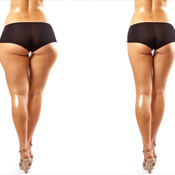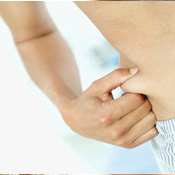Liposuction
!


Liposuction
Liposuction also known as liposhaping or liposculpturing, is a process of fat suctioning i.e. removing of unwanted accumulations of fat localised in certain part of the human’s body that normally do not respond to diet or exercise such as the abdomen, thighs, hips and knees, upper arms and upper breasts, calves and ankles, neck, chin and cheeks. Although liposuction introduces considerable improvements in the contours of the body and contributes to patient’s better self esteem, it can not be regarded as a substitute to weight loss and it does not affect cellulite. Liposuction is a procedure both suitable to men and women. Women normally use the procedure to reduce the fat deposits underneath their chin, in their hips, thighs and abdomen, underarms and breast area, while men have fat suctioned mainly from underneath their chin and around the waist area. Liposuction procedure known as gynecomasty can be successfully applied in men with enlarged breast tissue.
Who is a good candidate for liposuction?
The patient should have a firm and elastic skin which will guarantee a good appearance once the procedure has been completed. In addition the right candidate should be healthy, mentally stable and with realistic expectations. Should the patient’s skin does not meet the required characteristics the patient may be recommended an alternative treatment that will produce better results. Liposuction is a procedure suitable not only for people with overweight. It is also a good solution for people with balanced weight who have excess of fat deposits in particular parts of their body. In number of cases the physician may refuse to perform the procedure due to the presence of heart or lung problem, weak blood flow or recent surgery in the area scheduled for liposuction.
Your first visit
During your first examination at the clinic, your physician will carefully examine your skin and specify the locations of fat deposits in your body. In addition he will perform a general check of your overall health and will also talk with you about your expectations and concerns. Alternative treatment methods such as abdominoplasty may be advised and discussed during you first visit. Sometimes a combination of both procedures may be recommended for achieving best results. Be sure to inform your surgeon of any substantial weight loss or gain that you have gone through at any stage of your life. If you happen to be a smoker, taking medications or being on a diet your doctor should also be aware of this.
Before the procedure
Your surgeon will supply you with detailed instructions and rules regarding eating, drinking and smoking, vitamin and drug intake that you will need to follow before to the operation. If you catch a cold or develop an infection prior to the surgery it will be better to delay it in time.
The procedure
Liposuction is normally a light, one-day procedure that rarely requires hospitalization. Depending on the scope of the surgery and the amount of fat required to be suctioned, the procedure may be performed under local or general anaesthesia. Normally when a liposuction is planned for more than one part of the body or is to be applied on a wider area, surgeon will perform a general anaesthesia. The duration of the procedure varies as well and could take anywhere between thirty minutes and couple of hours. The surgeon marks the places where liposuction is to be applied. Then he makes small incisions in the skin and inserts tiny stainless steel tube called cannula that leads out the fat and fluids sucked out by a powerful vacuum-pressure machine located at the tube’s end. The surgeon manipulates the cannula by pushing it deep into the fat layers underneath the skin. Occasionally secondary incisions in skin’s surface are made allowing the surgeon to reach some hardly accessible fat deposits. Along with the fat suctioning, you will lose considerable amounts of fluid therefore you will be flown some fluids intravenously during the treatment.
After the procedure
During your first check up at the clinic the surgeon will examine carefully the shape of your face, the bone and cartilage structure of your nose as well as the thickness of your skin. Those are the factors that will play a major part during and for the outcome of the operation. A consultation with your surgeon regarding your expectations and preferences about your new look is also important and should take place during your first visit. It is of utmost importance to inform your surgeon if you are a smoker, having respiratory problems or being allergic. Your doctor should be also aware of any nose reconstructive surgeries that you have had in the past. Please do not forget to mention if you are on any type of medication.
The Procedure
Up to the scale of the planned surgery, a nose job can be performed under local or general anaesthesia. The procedure is usually carried in one day, but sometimes an overnight stay at the clinic could be required. Although it is a generally complex procedure, the rhinoplasty lasts somewhere between two and four hours. In the majority of cases the surgeons carry out the procedure from inside the nose by performing an incision through the nostrils. When the procedure is more complicated, surgeons perform an 'open' surgery, performed by making an incision through the vertical tissue separating the nostrils called "columella". The open technique is preferred by surgeons, because it leaves almost no scarring and moreover, airway blockages and nasal cavity deformity can be rectified effecting into easier breathing. Throughout the operation, the supportive nose structure including the bone and the cartilage, is being detached from the nose's vault and reshaped according to patient's preferences. The nasal bones are drawn together to narrow down the lower part of the nose. The reducing of the nostrils' size is achieved by removing the triangular pieces from the base of the nose. If necessary the septum is reshaped in order to improve the angle between the nose and the upper lip. When the tip of the nose needs correction, the surgeon shaves off and reshapes the cartilages on the tip of the nose. Towards the end of the procedure a nasal cast, nasal packing or, if necessary, silicon sheets may be placed inside your nose to stabilise the septum, preserve the new shape and reduce the swelling.
After the procedure
Following the surgery some fluid may remain accumulated under the skin and therefore you may be put on a subcutaneous drainage tube for a couple of days. In order to minimize swelling, control bleeding and ease skin shrinking you may be recommended to put on a supportive wear onto the operated area such as slip-on, body stocking or corset. The supportive wear is to be taken off after 15 or 20 days according to doctor’s prescriptions. Antibiotics could be given to avoid infection.
The first days and weeks after the procedure will be the hardest for you. You may feel low and depressed. Due to the fluids flown, you may feel heavier, swelling and redness may be visible in the operated areas and slight burning could be experienced. Additionally there will be some stiffness and pain for two-three days that you can suppress with pain-killers. Temporary loss of sensation in the treated areas is possible but it will disappear eventually. As times go by you will begin to look and feel better.
Recovery
Any sutures used during the surgery will disappear or will be removed in a couple of days following the procedure. The patient may return to work and get back to other light every day activities in 14 days. You will need to get back to motion and walking as soon as possible in order to prevent any blood clot formation. It is essential however that you avoid strenuous activities for at least two or three weeks. In one or two months the swelling and redness of the skin will fade away in most of its part. Some swelling may remain persistent for a period of six months. Your surgeon may appoint with you a repeat visit at the clinic for following up the progress of your recovery.
Results
Liposuction produces excellent results in properly motivated patients as long as the procedure is being performed in modern and fully equipped clinical conditions and by a skilled certified surgeon. Scars left after a liposuction procedure are relatively small and hard to notice even when wearing your bikini. The beneficial results gained though a fat suctioning procedure may be long even life time lasting provided that you maintain your dietary regimen and regular exercises. Even though you may gain few pounds after the surgery, the newly formed fat deposits will not accumulate in the operated areas but rather will be distributed evenly over your body. The majority of patients who undergo this aesthetic treatment express satisfaction with their new appearance. As a result of the fat suctioning you will acquire a slimmer silhouette and more proportionate body lines that will imminently boost yourself-confidence and will help you feel good in your own skin.
Possible Risks
Liposuction is generally safe and less invasive procedure that hardly involves any risks. In some rare cases when fat deposits are suctioned from several parts of the body all in one operation session as well as over wide areas of the body, patient may develop some serious trauma. Skin scarring and fluid accumulation are also possible but rare complications. Although extremely rare, heavy complications such as infection or significant fluid loss may cause serious distress. Even in the hands of a most experienced surgeon some small post operational cosmetic imperfections may remain such as asymmetry, skin irregularities, skin sagging or colour alternations in the operated area.
